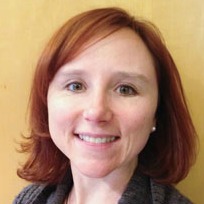EDITORS’ NOTE: Choosing a research lab is a pivotal decision in the trajectory of a biomedical sciences graduate student or physician scientist. After two or three laboratory rotations, Ph.D. candidates (at the end of the first year) and M.D./Ph.D. candidates (at the end of the second year) determine which labs are exploring the scientific questions that interest them most and which represent the best fit in terms of lab culture and environment.

Teresa Bowman, Ph.D.
Each year, more than 100 Einstein faculty members and graduate students gather for a poster session to showcase their research while providing a forum for Ph.D. and M.D./Ph.D. candidates to ask questions and learn more about specific research from later-year graduate students and principal investigators.
Following Einstein’s session earlier this month, we asked fourth-year Ph.D. candidate Abubakar Jalloh and PI Teresa Bowman, Ph.D. for their perspectives on pursuing scientific discovery at Einstein. Abu and three other students also shared their experiences on camera at the event.
The Doctor’s Tablet: Abubakar, you study sugar molecules and their cell interactions in the lab of PI Peng Wu, Ph.D. What is it like being at a poster session and talking to fellow students and faculty members about the work you’re involved in?
Abubakar: Aside from being great practice for an outside conference or a seminar, the poster session allows me to take a step back from the jargon my lab mates and I are accustomed to and take the position of the audience members, be they first-year graduate students, postdocs or even faculty members who are not familiar with our work. The annual poster sessions provide a great venue to perfect one’s sales pitch, to recruit new students and to set up new collaborations.
With the only other student from my lab graduating this month, I took it upon myself to use the occasion to recruit new students to our lab.
The Doctor’s Tablet: How does Einstein’s environment help deepen scientific inquiry and discovery?
Teresa: At Einstein, the faculty is fully committed to providing our students with rigorous and scholarly training. It is an exceptionally collegial environment where students can learn the value of collaborative science. Here, student input not only is highly valued, it is expected. Einstein is the perfect fit for a student looking for scientific rigor and diversity, but also an intimate learning experience.
Abubakar: Working in the Price Center means sharing a floor with members of other departments whose focus areas, expertise and equipment are entirely different from ours—a biochemistry lab. This overarching diversity allows us to ask questions that have not been asked before and test hypotheses in ways we have never done before.
In a way, this setup forces us to work on interdisciplinary projects that will benefit both parties (both labs) involved. In fact, my current project, which lies at the interface of immunology and biochemistry, was conceived from a casual conversation between my advisor (a chemist by training) and our next-door neighbor (an immunologist by training).
The Doctor’s Tablet: Teresa, as an investigator, what benefit do you see from interacting with grad students as they begin their lab-selection process?
Teresa Bowman: It is important to meet the students at the beginning of their selection process, when their minds are still open. It is the first step in a rotation process that allows the students to explore many scientific avenues and lab environments to find the right fit. I like it because we get to showcase the newest and most exciting aspects of our lab to attract new students.
The Doctor’s Tablet: Abubakar, share with us an “aha” science moment you’ve had while pursuing your Ph.D. at Einstein.
Abubakar: I was returning from an eight-mile run to Orchard Beach last month when it occurred to me that my current data prove only that I can do the same thing that much smarter people have done in decades past. In an ideal world I’d have to show that my technique is faster (it wasn’t) or cheaper (not necessarily) or at least cleaner, meaning a better predictor of cell activity. So I went back to the lab and went through data I had collected from the five antibodies at my disposal—pitching each one against our homemade small molecule. Two hours and twenty healthy and infected cells later, I realized that my reagent could replace three of the antibodies, making our system more efficient and a better predictor of activated T cells.

